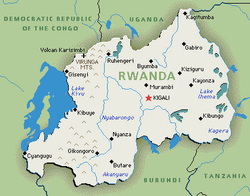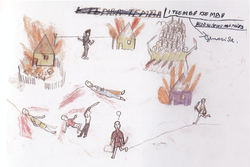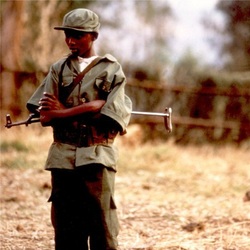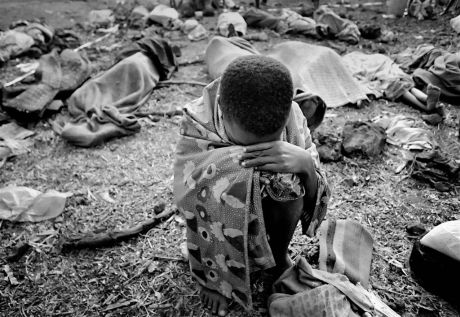
- 1894 Germany colonizes Rwanda.
- 1918 The Belgians assume control of Rwanda.
- 1933 The Belgians organize a census and mandate that everyone be issued an identity card classifying them as either Tutsi, Hutu, or Twa.
- December 9, 1948 The United Nations passes a resolution which both defines genocide and declares it a crime under international law.
- 1959 A Hutu rebellion begins against the Tutsis and Belgians.
- January 1961 The Tutsi monarchy is abolished.
- July 1, 1962 Rwanda gains its independence.
- 1973 Juvénal Habyarimana takes control of Rwanda in a bloodless coup.
- 1988 The RPF (Rwandan Patriotic Front) is created in Uganda.
- 1989 World coffee prices plummet. This significantly affects Rwanda's economy because coffee was one of its major cash crops.
- 1990 The RPF invade Rwanda, starting a civil war.
- 1991 A new constitution allows for multiple political parties.
- July 8, 1993 RTLM (Radio Télévison des Milles Collines) begins broadcasting and spreading hate.
- August 3, 1993 The Arusha Accords are agreed upon, opening government positions to both Hutu and Tutsi.
- April 6, 1994 Rwandan President Juvénal Habyarimana is killed when his plane is shot out of the sky.
- April 7, 1994 Hutu extremists begin killing their political opponents.
- April 9, 1994 Massacre at Gikondo - hundreds of Tutsis are killed in the Pallottine Missionary Catholic Church. Since the killers were clearly targeting only Tutsi, the Gikondo massacre was the first clear sign that a genocide was occurring.
- April 18, 1994 The Kibuye Massacres. An estimated 12,000 Tutsis are killed after sheltering at the Gatwaro stadium in Gitesi. Another 50,000 are killed in the hills of Bisesero. More are killed in the town's hospital and church.
- April 28-29 Approximately 250,000 people, mostly Tutsi, flee to neighboring Tanzania.
- May 23, 1994 The RPF takes control of the presidential palace.
- July 5, 1994 The French establish a safe zone in the southwest corner of Rwanda.
- July 13, 1994 Approximately one million people, mostly Hutu, begin fleeing to Zaire (now called the Democratic Republic of the Congo).
- mid-July 1994 The Rwanda Genocide ends when the RPF gains control of the country.
Pre - Genocide: Rwanda
"Rwanda was once called 'a tropical Switzerland in the heart of Africa'." It was a beautiful place with people working together in harmony. Belgium was given administration over Rwanda under the League of Nations mandate in 1919. The Belgian administration then divided the people there in to two separate groups we have come to know as The Hutu people and The Tutsi people. They did so by introducing Identity cards which made it easy for them to identify between the Hutu and Tutsi. Colonial practices were in motion in Rwanda once Belgium had a presence. The Belgian administration chose a privileged/educated class which would serve as "intermediaries between the Governor and the Governed.(www.ppu.org)." They chose the Tutsi to be this class because they were typically all landowners and to the Belgians they looked more European in their traits which gave them an aristocratic stature and gave the Hutu a lower class position within the Bureaucratic structure of Rwanda. Soon both people started acting according to the roles they were appointed the Tutsi took on this aristocratic position and they treated the Hutu people as servants. The introduction of Identity cards which were used to distinguish between the two people and the Belgians preference to the Tutsi over the Hutu brought about Class consciousness. Missionaries to Rwanda added a new political twist which worsened the relations between the two people. The Church was instilling in concrete form the class consciousness introduced by The Belgians'. The institution of Religion fed the people an idea that the Hutu people were "oppressed" and this eventually inspired them to revolt against the Tutsi. The Belgian admin. quickly changed sides and started backing the Hutu's in their revolution. In 1957 a manifesto denouncing the Tutsi leadership and their perceived dominant presence. King Rudahingwa of Rwanda dies in 1959 under strange circumstances while under the care of a Belgian doctor. There was a outbreak of violence due to a peasant revolt which left 20,000 Tutsi's dead. As the violence continued thousands fled as refugees to Uganda an estimated 200,000 Tutsi's settled there. In 1962 Rwanda gains freedom from Belgium and George Kayibanda who was a member of the Huto nationalist party comes to power. A few years later Kayibanda was overthrown by his own party member President Habyarimana. From 1963-67 100,000 Tutsi's still in Rwanda were massacred with Machetes and clubs. In 1973 Tutsi students became a target and were also massacred. Conditions for Tutsi's worsened in Rwanda they were not allowed to part of the political infrastructure, they were only allowed work 9% of the jobs alloted, and their children were not to attended secondary education and college. The Economy of Rwanda takes a huge hit in 1989 due to coffee prices dropping and coffee was their major cash crop . This only aggravated the tensions between the people. From 1959-1980's the Tutsi's exiled to other countries formed a militia and called themselves RPF (Rwandan patriotic front). In October 1990 they seized an opportunity and invaded Rwanda in the hopes of coming to an agreement with the government to share the power between the two people. Upon invasion the RPF met with Government forces who were equipped/trained by France and Zaire whom the RPF fought until March 1993 when there was a ceasefire declared. Rwanda was to work towards a Multi-party Government but this idea was fiercely opposed by the Hutu people both in power and under it. After signing an agreement with the RPF President Habyarimana's was returning to Kigali, Rwanda when his plane was shot down by an extremist and this was a catalyst that immediately caused Genocide.
The Genocide

The Hutu people in Power were waiting for this type of incident to put in motion their "final solution" for the Tutsi "problem." The Tutsi's were accused for the death of the President and The Hutu people were told by word of mouth and radio to kill all Tutsi's. The Hutu's were told it was their duty and they were to also kill anyone that sided with Tutsi's which included adults, children, people from other nationalities as well as Hutu sympathizers. Genocide began in the streets.
Over the next 100 days over 800,000 lives were taken. Entire Families would flee and try to seek safety in places such as churches but they would be raided. Adults and children were masacured together. The few children that did survive these brutal attacks only did so by pretending to be dead and continueing to live among the corpses for many days after. The Id cards issued to all Rwandians by the belgiums played a key role in these attacks. They showed who was considered Tutsi and who was not. They were required to show them when anyone moved from one place to another. These horricfic attacks were not lead soley by the military, everyday Hutu people would kill their neighbors and friends. They would gather together and raid buildings. These horrific events left over 95,000 orphans.
Over the next 100 days over 800,000 lives were taken. Entire Families would flee and try to seek safety in places such as churches but they would be raided. Adults and children were masacured together. The few children that did survive these brutal attacks only did so by pretending to be dead and continueing to live among the corpses for many days after. The Id cards issued to all Rwandians by the belgiums played a key role in these attacks. They showed who was considered Tutsi and who was not. They were required to show them when anyone moved from one place to another. These horricfic attacks were not lead soley by the military, everyday Hutu people would kill their neighbors and friends. They would gather together and raid buildings. These horrific events left over 95,000 orphans.
Child Soldiers

The use of child soldiers in the Rwanda Genocide is not something to ignore. These were not children who willingly volunteered to serve. These children would one day be playing and the next thing they knew they were standing in ranks learning how to kill their friends. Many of these children did not want to harm anyone but if they did not comply with their orders they were killed. there are laws about children being used in the military in Rwanda but those were utterly ignored. no one under the age of 17 is allowed to join as well as no one under the age of 14 can be tried for crimes of murder during the genocide. Many of the Children forced to kill were well under the age of 14.
Post-Genocide
There is now a participatory court system called Gacaca which holds trials for the perpetrators involved in causing the Genocide. Paul Kagame has been re-elected to serve as President of Rwanda and under his command there has been much progress in the healing of Rwanda.A lot of refugees were evicted from their host country and nearly a million Rwandans returned home. The Government now has strict laws about the emphasis on race and identity which separates groups. Unfortunetly Violence has not left Rwanda completely after the Genocide what followed was a series of wars known as the First and Second Congo wars which killed 5 million people from 1998 to 2004.
Present day Visitors STILL think it's a beautiful country. ('Beautiful?' said one Rwandan. 'After the things that have happened here?')
Responsible Parties and their Involvement.
Romeo Dallaire
General of the UNAMIR sent troops to Rwanda. During the Genocide the UN pulled out troops from Rwanda. There were approximately 200 troops left with Dallaire and instead of following orders to leave the Genocide he went into it doing the best he could to save anyone he could. He would eventually write many books condemning various institutions and their failure in Rwanda. He is still alive and a Humanitarian agent for Canada his home country.
Kofi Annan
is held accountable by many including Dalliare (above) for his lack of action in Rwanda. He was appointed Under Secretary General of UN and when UNAMIR troops called for action his response was extremely delayed. He added more time to the Genocide.
UNAMIR
http://www.un.org/en/peacekeeping/missions/past/unamirS.htm
Paul Kagame
Current president since March 2000. He took over as General in the RPF when General Fred Rwingema died. This man is credited for Rwanda being "Africa's biggest sucess story" he ensured that aid got to his people and they became self reliant people.
Testimonial of a Witness'The river Kagera flows into a steep ravine that forms the natural border between Tanzania and Rwanda. There is a small waterfall where the river narrows before entering the gorge. In the rainy season the river swells. As it sweeps down from the highlands, it gathers into its currents huge clumps of elephant grass and numerous small trees. In the late spring of 1994 it was much the same with human corpses. They, too, twisted and turned, rose and dropped and came bouncing over the falls before they found the still water which would carry them down to Lake Victoria. They did not look dead. They looked like swimmers, because the strong currents invested them with powers of movement. So lifelike did they appear that for a few moments I winced as I watched them thrown against the rocks, imagining the pain they must be feeling. It was only beyond the falls, where they floated lifeless among the trees and grass, that one could accept the certainty of death. The border guards told me people had been floating through in their hundreds, every day for weeks. Many had their hands tied behind their backs. They had been shot, hacked, clubbed, burned, drowned.'
'Those victims who escaped death carry on as best they can, often not very well. What they say today is what they said yesterday and what they will go on saying: for them time came to a halt and they can find no peace of mind. They complain that they have been abandoned. They are the ones who have to face all the grievances, sometimes compassion, sometimes others' shame for what they have done. At first sight they seem to be enclosed in a silence so profound it's frightening. Then sometimes, just a word, just a look, just a few moments' wait will turn a victim into an eyewitness. In a feeble but clear monotone they will tell you, as they stare at the ground, how they escaped the worst fate; they're alive, they're lucky. And one of the first things they tell you is that they are one of those whom death refused. Then they describe what they witnessed, acts of unbearable horror.'
'In the schoolrooms and church halls where they were slaughtered, many of the dead have been left unburied, to form their own memorial. The rooms are empty except for trestle tables on which collected bodies and bones have been laid, entangled. In one room the faded, shapeless clothes of the dead have been strung on motionless lines: curiously beautiful. In another it's the floor that supports the barely recognisable decomposed remains, lost in a sleep more fast than most of us get to know. There is no smell, there are no flies. The atmosphere is, in fact, intensely peaceful; the scene is deeply moving. It is also full of unspeakable sorrow.'
Important Terms
Hutu- The majority of the population of Rwanda. Mostly made up of farmers.
Tutsi- The minority group of Rwanda, they migrated from northern Africa. Mostly made up of farmers.
Khubohoza
means “to help set you free”It sounds good, but it isn’t. The men who used it
were bullies who wanted others to do as they say.
They rubbed white chalk on their faces and dressed in banana leaves to
make themselves look scary. Then
they burst into your house waving spears and big knives.
They pretended that someone else was bullying you, and they acted as if
they had come to set you free. – quote from Christophe’s story
Tutsi- The minority group of Rwanda, they migrated from northern Africa. Mostly made up of farmers.
Khubohoza
means “to help set you free”It sounds good, but it isn’t. The men who used it
were bullies who wanted others to do as they say.
They rubbed white chalk on their faces and dressed in banana leaves to
make themselves look scary. Then
they burst into your house waving spears and big knives.
They pretended that someone else was bullying you, and they acted as if
they had come to set you free. – quote from Christophe’s story
Related Childrens Literature
Deogratias,A Tale of Rwanda: J.P.
Stassen
Witness to Genocide: The Children of Rwanda: Drawings by Child
Survivors of the Rwandan Genocide of 1994 by Richard A. Salem and Hillary Rodham
Clinton (May 17, 2000)
This book is an incredibly powerful book.It gives you an idea of the horrors that children livd through and how they saw what was going on.
They
Fight Like Soldiers, They Die Like Children: The Global Quest to Eradicate the
Use of Child Soldiersby Roméo
Dallaire
and Ishmael Beah
(May 24, 2011)
Shake hands with the Devil: The loss of Humanity in
Rwanda by Romeo Dallaire
Christophe's Story Nikki Cornwell (Author), Karin Littlewood (Illustrator)
After witnessing the murder of his brother, his famly managed to get out out of the country and start a new life. when christophe starts his new school the teacher asks him to tell his story. it expresses the importance of oral traditions.
sources
. "united human
rights council." Genocide in Rwanda. N.p., 2012. Web. 18 Sep 2012.
<http://www.unitedhumanrights.org/genocide/genocide_in_rwanda.htm>.
. "Rwandan SOS
Child who became Child Soldier ." . N.p., n.d. Web. 18 Sep 2012.
<http://www.child-soldier.org/Rwanda>.
Rosenberg,
Jennifer. "Jennifer Rosenberg."
<http://history1900s.about.com/od/rwandangenocide/a/Rwanda-Genocide-Timeline.htm>.
rights council." Genocide in Rwanda. N.p., 2012. Web. 18 Sep 2012.
<http://www.unitedhumanrights.org/genocide/genocide_in_rwanda.htm>.
. "Rwandan SOS
Child who became Child Soldier ." . N.p., n.d. Web. 18 Sep 2012.
<http://www.child-soldier.org/Rwanda>.
Rosenberg,
Jennifer. "Jennifer Rosenberg."
<http://history1900s.about.com/od/rwandangenocide/a/Rwanda-Genocide-Timeline.htm>.

